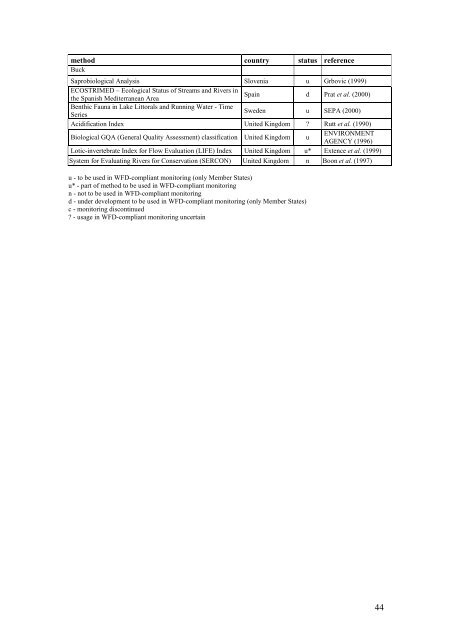Report on Harmonisation of freshwater biological methods
Report on Harmonisation of freshwater biological methods Report on Harmonisation of freshwater biological methods
method country status referenceBuckSaprobiological Analysis Slovenia u Grbovic (1999)ECOSTRIMED – Ecological Status of Streams and Rivers inthe Spanish Mediterranean AreaSpain d Prat et al. (2000)Benthic Fauna in Lake Littorals and Running Water - TimeSeriesSweden u SEPA (2000)Acidification Index United Kingdom ? Rutt et al. (1990)Biological GQA (General Quality Assessment) classification United Kingdom uENVIRONMENTAGENCY (1996)Lotic-invertebrate Index for Flow Evaluation (LIFE) Index United Kingdom u* Extence et al. (1999)System for Evaluating Rivers for Conservation (SERCON) United Kingdom n Boon et al. (1997)u - to be used in WFD-compliant monitoring (only Member States)u* - part of method to be used in WFD-compliant monitoringn - not to be used in WFD-compliant monitoringd - under development to be used in WFD-compliant monitoring (only Member States)c - monitoring discontinued? - usage in WFD-compliant monitoring uncertain44
Annex IV: Analysis of lake biological monitoring methods(Intercalibration metadata at 14/01/2004)CHLOROPHYLL1. The WFD allows for the use of chlorophyll a as surrogate for phytoplanktonbiomass and, thus, is considered a biological parameter, and the most frequentlymeasured in lakes. In the GIGs the percentage of lakes for which chlorophyll a ismeasured varies between 40% (Eastern Continental, EC) and 100% (Mediterranean,ME), with an overall average of 82.5% (Fig. 1). A possible explanation for a smallerpercentage of lakes with chlorophyll a data in the Eastern Continental and NorthernGIGs could be a monitoring strategy targeted to identify acidification impacts and forwhich chlorophyll a is less used.Percentage measuring Chl-a per GIG1008060%40200AL AT BA CE EC ME NOFigure 1. Percentage of lakes for which chlorophyll a is measured in the GIG (Al= Alpine;AT= Atlantic, BA= Baltic; CE= Central; EC= Eastern continental, ME= Mediterranean,NO= Northern).2. However, there is great heterogeneity both within GIG and between GIGs in termsof the sampling methods. Most lakes in the GIGs are sampled for chlorophyll abetween 2 and 12 times per year (Fig. 2), and samples are taken over the whole year(monthly) or concentrated during spring, summer, or vegetation periods (Fig. 3).45
- Page 1 and 2: Institute for Environment and Susta
- Page 3 and 4: CONTENTSBackground and purpose of t
- Page 5 and 6: Background and purpose of the docum
- Page 7 and 8: States and candidate countries. Inf
- Page 9 and 10: classification, each of these being
- Page 11 and 12: BIOLOGICAL QUALITY ELEMENT: PHYTOPL
- Page 13 and 14: indicators, species lists, frequenc
- Page 15 and 16: 53. The identification and enumerat
- Page 17 and 18: 64. In general, this technique is t
- Page 19 and 20: RIVER BIOLOGICAL QUALITY ELEMENT: F
- Page 21 and 22: 84. The development of specific sta
- Page 23 and 24: practice guides for identification
- Page 25 and 26: 100. The information received from
- Page 27 and 28: Evaluation of the suitability of cu
- Page 29 and 30: group should update its primary fin
- Page 31 and 32: ReferencesAFNOR (Association Franç
- Page 33 and 34: EN ISO 8689-2 Water quality - Biolo
- Page 35 and 36: Lazaridou-Dimitriadou, M., C. Kouko
- Page 37 and 38: Shannon, C.E. and W. Weaver, 1949.
- Page 39: Annex I: Composition of the Geograp
- Page 43: Annex III: River biological assessm
- Page 47 and 48: Number of sampling stations10080%60
- Page 49 and 50: IT 90% acetone spectrophotometricPT
- Page 51 and 52: 10. The sampling depth and volume s
- Page 53 and 54: PTESFIIE5667-2/98 Romanianstandardi
- Page 55 and 56: Sampling stations%1008060402001 2-1
- Page 57 and 58: MACROPHYTES16. The aquatic Macrophy
- Page 59 and 60: Plants sampled per GIG1008060%40Eme
- Page 61 and 62: NO qualitativ method species number
- Page 63 and 64: indicators, species lists, frequenc
- Page 65 and 66: 26. The sampling frequency is varia
- Page 67: CEN/TC 230/WG 2/ TG 4 N28, 2 nd wor
- Page 70 and 71: programs are based only on the diat
- Page 72 and 73: 21. Some countries like France, Est
- Page 74 and 75: Table 1. European methods for monit
- Page 76 and 77: countries also covers Non-EU Member
- Page 78 and 79: 49. The Danish Stream Fauna Index i
- Page 80 and 81: Hungary58. Since 2002 a modificatio
- Page 82 and 83: Acidification Index, based on the s
- Page 84 and 85: Identification is predominantly to
- Page 86 and 87: size of the net range between 250 t
- Page 88 and 89: water bug genus (Aphelocheirus) and
- Page 90 and 91: Table 5. Common abundance classific
- Page 92 and 93: 108. Process Assessment focuses on
method country status referenceBuckSapro<strong>biological</strong> Analysis Slovenia u Grbovic (1999)ECOSTRIMED – Ecological Status <strong>of</strong> Streams and Rivers inthe Spanish Mediterranean AreaSpain d Prat et al. (2000)Benthic Fauna in Lake Littorals and Running Water - TimeSeriesSweden u SEPA (2000)Acidificati<strong>on</strong> Index United Kingdom ? Rutt et al. (1990)Biological GQA (General Quality Assessment) classificati<strong>on</strong> United Kingdom uENVIRONMENTAGENCY (1996)Lotic-invertebrate Index for Flow Evaluati<strong>on</strong> (LIFE) Index United Kingdom u* Extence et al. (1999)System for Evaluating Rivers for C<strong>on</strong>servati<strong>on</strong> (SERCON) United Kingdom n Bo<strong>on</strong> et al. (1997)u - to be used in WFD-compliant m<strong>on</strong>itoring (<strong>on</strong>ly Member States)u* - part <strong>of</strong> method to be used in WFD-compliant m<strong>on</strong>itoringn - not to be used in WFD-compliant m<strong>on</strong>itoringd - under development to be used in WFD-compliant m<strong>on</strong>itoring (<strong>on</strong>ly Member States)c - m<strong>on</strong>itoring disc<strong>on</strong>tinued? - usage in WFD-compliant m<strong>on</strong>itoring uncertain44



